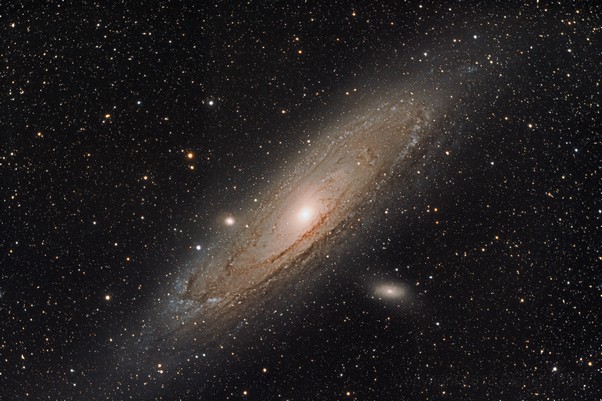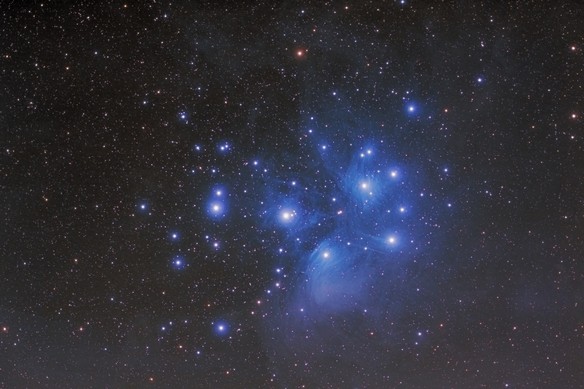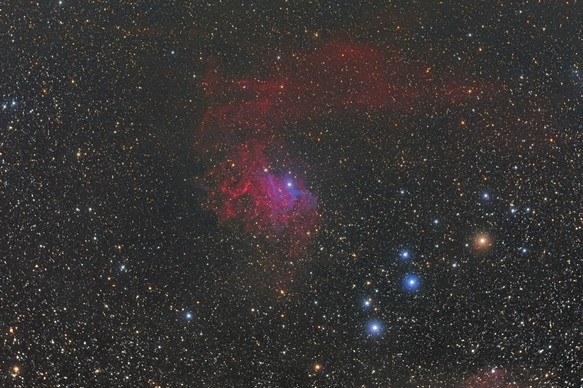What can you see with a telescope?
Colored and vivid images of galaxies, planets and star clusters entrance everyone who is fascinated by boundless space, occupied by myriad stars, and is eager to see the wonders of the Universe. Inspired by the experience of astrophotographers, some of you might want to go for this engrossing hobby. On the one hand, it seems quite easy: unlike with, for example skating or golf, no specific skills or long workouts are needed. Just buy a telescope with a fitting lens, wait until dark and it’s all sorted – you can enjoy the views of twinkling stars. Some even think that as soon as they point their telescope at the night sky, multicolored planets the size of a soccer ball as well as star clusters and even whole galaxies will start popping up out of nowhere. Like in the movies. Or maybe a comet will fly before you and wave its shining tail? Alas, no. The smartest of you probably have already guessed that the reality is somewhat more prosaic. Nevertheless, using a telescope properly will allow you to see countless space objects that have a good chance of leaving you completely speechless. In case you are intrigued and trying to wrap your mind around how to start this fascinating hobby, no worries – we’ve got your back here. Just follow this article for advice and FAQs on beginners’ astronomy.
To start, let’s try to figure out how telescopes work. First, the magnification power – the ability to zoom in on distant objects – has actually little to do with the quality of the picture you see in the telescope. Even the cheapest telescope can magnify as much as you want, but that doesn’t mean you will be able to make out anything. The main characteristic of a telescope is its resolution, or the ability to draw two closely located details in focus. Imagine a phone camera, for example. Do you remember the old Nokia phones with 1–2 megapixel cameras? And now compare them with IPhone 7 cameras. Both cameras look pretty much the same; can zoom in and zoom out. But the pictures you take are completely different: one is dull and blurry, without any details. The other one is beautiful and bright; you can even see the tips of your eyelashes. It’s all about the resolution. The same principle works for telescopes. Imagine that the telescope is the “camera” fitted into your eye. If you buy a cheap and simple “camera”, you can clearly see objects magnified 70 times. If you magnify further, objects will become dim and fuzzy. But if you have a good, expensive camera, you can get a magnification of up to 500 times, without losing the quality of the picture, while the sizes of the objects on the pictures will be same.
The resolution is measured in angular seconds (it’s only 0.00028 degrees). The larger the diameter of the lens, the better the resolution; hence the more distant objects can be seen. Ideally, for the best image quality the magnification should be no more than the diameter of the lens in millimeters. For example, a 100mm lens will be perfect for a 100x magnification. Some increase the magnification up to 1.5-2 times when the lens is rather good quality and in fair atmospheric conditions. We wouldn’t recommend increasing magnification any further.
You probably can’t wait to find out what you can see in the telescope. We are ready to share it with you. First, let’s dispel a few popular myths:
Can I see satellites?
Nope, they move too fast. You can hardly have it in your sights.
Can I see stars through the telescope?
Well, see – yes. Make out the details – no. The only star you can see in detail is the Sun.
To start, let’s try to figure out how telescopes work. First, the magnification power – the ability to zoom in on distant objects – has actually little to do with the quality of the picture you see in the telescope. Even the cheapest telescope can magnify as much as you want, but that doesn’t mean you will be able to make out anything. The main characteristic of a telescope is its resolution, or the ability to draw two closely located details in focus. Imagine a phone camera, for example. Do you remember the old Nokia phones with 1–2 megapixel cameras? And now compare them with IPhone 7 cameras. Both cameras look pretty much the same; can zoom in and zoom out. But the pictures you take are completely different: one is dull and blurry, without any details. The other one is beautiful and bright; you can even see the tips of your eyelashes. It’s all about the resolution. The same principle works for telescopes. Imagine that the telescope is the “camera” fitted into your eye. If you buy a cheap and simple “camera”, you can clearly see objects magnified 70 times. If you magnify further, objects will become dim and fuzzy. But if you have a good, expensive camera, you can get a magnification of up to 500 times, without losing the quality of the picture, while the sizes of the objects on the pictures will be same.
The resolution is measured in angular seconds (it’s only 0.00028 degrees). The larger the diameter of the lens, the better the resolution; hence the more distant objects can be seen. Ideally, for the best image quality the magnification should be no more than the diameter of the lens in millimeters. For example, a 100mm lens will be perfect for a 100x magnification. Some increase the magnification up to 1.5-2 times when the lens is rather good quality and in fair atmospheric conditions. We wouldn’t recommend increasing magnification any further.
You probably can’t wait to find out what you can see in the telescope. We are ready to share it with you. First, let’s dispel a few popular myths:
Can I see satellites?
Nope, they move too fast. You can hardly have it in your sights.
Can I see stars through the telescope?
Well, see – yes. Make out the details – no. The only star you can see in detail is the Sun.
If you have high hopes to examine the stellar disks in detail and find out how the stars in the Ursa Major constellation differ from the stars in the Little Dipper – slow your roll here. The closest star to us, Proxima Centauri, is 7 times smaller than the Sun and is 4 light years away. In order to see it, you would need a telescope with a lens 140m in diameter, which is impossible in terrestrial conditions. The largest of the currently existing optical telescopes, the Grand Canary Telescope (Gran Telescopio Canarias), has a mirror of only 10.4 meters in diameter. Therefore, in the nearest future, we will only be able to see the stars as glowing blurred spots, surrounded by concentric rings.
How about the traces of the first man on the moon? American flag? Lunar rover?
No, no and no again. So why do we see whole galaxies far-far away, but cannot see the objects on the Moon right next to us? For the same reason as the distant stars. The resolving power of any optical telescope is too small to see such tiny objects, although they are at a much closer distance. Using the same Gran Telescopio Canarias telescope, you will be able to distinguish objects of this size at a maximum distance of 10,000 km. And the Moon is 380 thousand km away from us. Therefore, the smallest object that we can see on its surface must be at least 20m long. In addition to this, the galaxies glow and stand out against the dark background of outer space, and the objects left on the moon don’t. They do not have any contrast against the surface, and the most we could see there is a weak shadow. “Then why do I need a telescope?” – You ask with disappointment and stomp your feet. Don’t lose hope. There are tons of amazing, fantastic and beautiful things you can observe in a telescope.
1. The Moon
The Moon is the Earth’s only satellite and a wonderful object for observation. Even a small telescope will be enough to see its numerous craters, crevices, seas and furrows. With 100x and more magnification, it won’t even fit in your telescope’s field of view. You will have to observe it in sections. In good weather conditions you can see the Moon every night. Depending on the change of phases, you will be able to make out more and more details.

2. The Sun
Here it is, the one and only star that we can properly observe through the telescope. But hold your horses – make sure you have a reliable solar filter before observing the Sun. Smoky glasses, floppy disks and other DIY stuff is absolutely unacceptable! The Sun can be observed only through a special, professionally made solar filter. Otherwise, you can damage your eyes up to complete blindness – Ouch! Astronomers have a joke: “You can see the Sun through the telescope without a solar filter twice in your life: first with one eye, then with another”. Once you have a solar filter securely fixed on the telescope tube, you can start your observations. Even in the smallest telescope you can see sunspots – dark spots on the bright surface of the Sun. By watching these spots every day you can actually watch the Sun rotating; it rotates with the frequency of 25 days. The Sun is the only astronomical object you can observe during the daytime.
3. Planets
You can observe the Solar System planets in your telescope. They won’t look as big and bright as on the pictures taken by spacecraft flying nearby. Rather, they will look like small glowing spots. For example, Mercury will appear as a star if you observe it with a small telescope. If you use a bigger one, you will be able to see its phase – a small “hook”.
The brightest object in the sky after the Sun and the Moon is Venus, which is also called the morning star. Sometimes you can even see it with the naked eye during daytime. It is covered with a dense opaque atmosphere, so making out any details on the surface isn’t possible. But you can see the phases, similar to lunar ones.
Even with a large telescope, Mars is visible only as a small circle, so the myth that once a year you can see it in the sky as a huge red disk, the size of two moons – is, sadly enough, just a myth. During the so-called opposition period, when the distance between Mars and the Earth is minimal, you can see the dark spots on the planet, which are called the seas.
Saturn definitely won’t leave you disappointed. This is perhaps the most beautiful planet. The rings are visible even with the smallest telescope. But it’s still better to observe it with telescopes of 200 mm and more in diameter. Then you will be able to see its satellites, the main division between the rings (Cassini's gap) and the cloudy belts.
Jupiter, the first planet to be observed by ancient astronomers, is slightly flattened due to rapid rotation around its axis. Even with a small telescope, you can see two bands on the planet's disk – these are cloudy belts. Looking through a larger telescope, you can make out 5-6 bands as well as the famous giant vortex in the form of a red spot. You can also spot four Galilean satellites (Io, Europe, Ganymede, Callisto), which cast their shadows on Jupiter when they pass in front of it. Uranus and Neptune will be visible only as bluish-green glowing spots even through a large telescope.
4. Galaxies
Each galaxy has billions of stars but you can see them only as small white spots. With larger magnification you will be able to observe their forms and spiral arms. There are tons of colorful photographs of galaxies on the internet that are taken with electronic cameras. These pictures are made with a long exposure, when light is accumulated in the camera's matrix. As a result, they turn out to be very bright. However, we see space objects mostly in black and white as our eye is unable to make long exposures. One of the closest galaxies to us is the Andromeda Nebula. And when we say “closest”, what we actually mean is a distance of about 2.5 million light-years. Because of such great distance, we can only see how the galaxy looked 2.5 million years ago, when there were no people on Earth yet.

5. Star clusters
Star clusters, or Pleiades, can be spherical or scattered. All the stars in the cluster are interconnected by gravity and move as a unit in the gravitational field of the galaxy. Scattered clusters usually have random shape and do not concentrate towards the center. One of the most famous scattered clusters is the Pleiades in the constellation of Taurus. You can see scattered clusters as more or less uniform piles of stars. Spherical ones look like round spots, which will decay into stars if you use a telescope with a lens of 150mm or more in diameter. They resemble a swarm of bees: the closer to the center, the more densely they are located to one another.

6. Binary stars
Stars can rotate around other stars just like planets. Such pairs or small clusters of stars are called binary or multiple star systems. Although you won’t be able to see the stellar disks in detail, the binary stars are undoubtedly worth taking a close look at. Often they come in different colors; for example, one star is red and the other is yellow or blue. You can observe these little shining lights even with a small telescope or binoculars. One of the most beautiful binary stars is Albireo in the Cygnus constellation.
7. Nebulae
Nebulae are, same as galaxies, usually observed in a very dark sky. It is better to go farther away to the countryside, because urban illumination is likely to spoil the whole experience. You will also see nebulae only in black and white, because the human eye is unable to accumulate light and is insensitive to colors in the dark. Imagine yourself in a dark room. Look around – you will see all objects in the shades of gray. Our eye switches from the "color sensitivity" mode to the "photosensitivity" mode. If you want to see nebulae in detail, you will need a telescope with a diameter of at least 200mm. Although even with a small telescope, you still can see the Orion Nebula, the Ring in the constellation of Lyra, the Dumbbell Nebula in the Vulpecula constellation, and many others.

8. Comets
Comets appear in the night sky many times a year. You only need to know where and when to look for them (it would be nice to have a calendar of astronomical events). Same as nebulae and galaxies, comets are visible as small glowing spots, but they also have tails. Big and bright comets are rare guests; such events are widely spoken about in all astronomical news, so you can hardly miss them.
9. Earth-based objects
You can use your telescope not only for space observations, but also as a giant spyglass. Do you want to see a house far on top of a mountain? Or an outgoing train? See the writing on the billboard far away from you? You can observe all of those through your telescope. But remember that astronomical telescopes usually give an inverted image, so you will need an additional wrapping prism for Earth-based observations.
Well, now you know the basics of astronomical observations. You probably won’t succeed the first few times, until you develop certain skill. But the more you practice and try different telescopes and filters, the more colorful and diverse objects you will see. Or even take a picture of, if you want to. What is more important, you don’t necessarily need an expensive telescope – an experienced amateur with a small telescope achieves better results than a beginner with a bunch of expensive optical equipment. Astronomy and astrophotography are two fascinating hobbies that have many followers around the world. Drive out to the countryside, climb to the roof of your house, share your astropictures with friends and take your telescope on a journey – your possibilities are limited only by your own imagination.
Don’t forget to check our ‘Telescopes’ section to choose the right one for you.
Any reproduction of the material for public publication in any information medium and in any format is prohibited. You can refer to this article with active link to eu.levenhuk.com.
The manufacturer reserves the right to make changes to the pricing, product range and specifications or discontinue products without prior notice.


